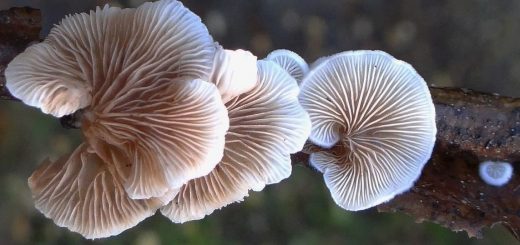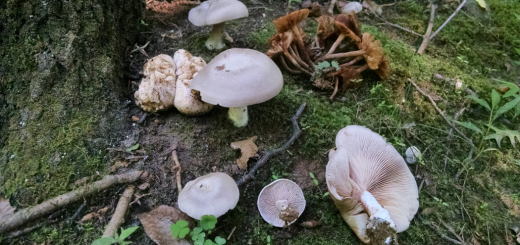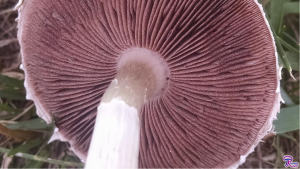#044: Mushroom Morphology: Earthstars
In celebration of Independence Day, I will be discussing the festively-shaped earthstars. Earthstars are characterized by a puffball-like sphere surrounded by a star-shaped base. The earthstars all have a three-layered peridium (the surface that covers the developing spore tissue). At maturity, the two outer layers split into rays and peel back to form the star-shaped base. The endoperidium (interior layer) then develops an ostiole (pore) ringed by a peristome through which spores are discharged. Earthstars are included in the gastromycetes, which all form their spores internally and cannot forcibly discharge their spores. Instead, like the puffballs, spores of earthstars are forced out of the pore when raindrops land on the endoperidium. All earthstars have capillatum, a network of cells designed to help spores move to the pore when a raindrop strikes the mushroom. If you cut open an earthstar you will find that it looks nothing like the interior of a puffball. Earthstars have a columella, which is a bulbous part of the sterile base at the center of the spore-producing gleba. The gleba is also broken up into sections which radiate out from the columella.
There are a number of variations on this basic morphology. Earthstars like Geastrum triplex and Geastrum saccatum have four to ten points and the gleba remains nestled in a small bowl at the center of the star. Some earthstars, like Geastrum corollinum, have hygroscopic rays that open in wet weather and close in dry weather. Other earthstars elevate the gleba. Geastrum pectinatum accomplishes this by using the points of the star to lift the entire fruiting body off the ground. It also forms a pedicel that slightly raises the gleba above the center of the star. In Geastrum fornicatum the mesoperidium (middle layer) splits from the exoperidium (outer layer), except at the tips of the star. This allows the mushroom to elevate its gleba while remaining attached to the ground, which helps it withstand high winds in desert areas. The fungus Myriostoma coliforme is unique among earthstars because it forms multiple pores.
There are a couple earthstar look-alikes that are worth mentioning. The first is Astraeus hygrometricus, the “Barometer Earthstar.” This mushroom does not have the internal organization of the earthstars and also forms a ragged pore. The Barometer Earthstar is actually related to the false puffballs (see FFF#042 for more). The other earthstar look-alike is Scleroderma polyrhizum. This mushroom forms irregular rays and exposes its gleba immediately upon opening. The powdery spores are immediately visible and clearly demonstrate that S. polyrhizum is a false puffball, not an earthstar.
The earthstars form a monophyletic group (they are all descended from a single common ancestor) and are placed in the phylum Basidiomycota, class Agaricomycetes, order Geastrales, and family Geastraceae. This family also includes the “Cannonball Fungus,” Sphaerobolus stellatus (see FFF#122 and #043 for more). The most prominent genus in this family is Geastrum, which literally means “earth-star.” Earthstars are also grouped into the “Gomphoid-Phalloid Clade”. Although the phylogenetic relationships of the species in this clade are not entirely worked out, this placement means that the closest relatives of the earthstars are the chanterelle genus Gomphus, stinkhorns, and the coral fungus genus Ramaria. The spore dispersal mechanism and capillatum typical of earthstars can also be found in the puffball genus Lycoperdon. Because of this it was thought that Lycoperdon species were related to the earthstars. However, modern genetic analysis has revealed that Lycoperdon belongs in the order Agaricales. This shared morphology is an excellent example of convergent evolution. Earthstars are considered inedible.
See Further:
http://www.mushroomexpert.com/puffballs.html (see the links for Geastrum spp.)
http://botit.botany.wisc.edu/toms_fungi/dec2003.html
http://en.wikipedia.org/wiki/Geastraceae
Miller & Miller, “North American Mushrooms…” http://books.google.com/books?id=zjvXkLpqsEgC&printsec=frontcover&source=gbs_atb#v=onepage&q=geastrum&f=false
http://blog.mycology.cornell.edu/2014/06/03/twinkly-earthstars/









![#011: Characteristics of Kingdom Fungi [Archived]](https://www.fungusfactfriday.com/wp-content/themes/hueman/assets/front/img/thumb-small-empty.png)


1 Response
[…] S. stellatus grows up to 3mm (very tiny!) across and is yellow-orange to whitish in color. This makes it nearly impossible to spot when growing on wood. When I find these mushrooms, it’s usually because I’ve stopped to examine another small mushroom such as a bird’s nest mushroom. Newly-forming fruiting bodies are white spheres that are too small to measure with a normal ruler. As the spheres get older, the top of the mushroom splits into triangular rays (usually between four and nine), much like a minuscule earthstar (see FFF#044).1,4 […]